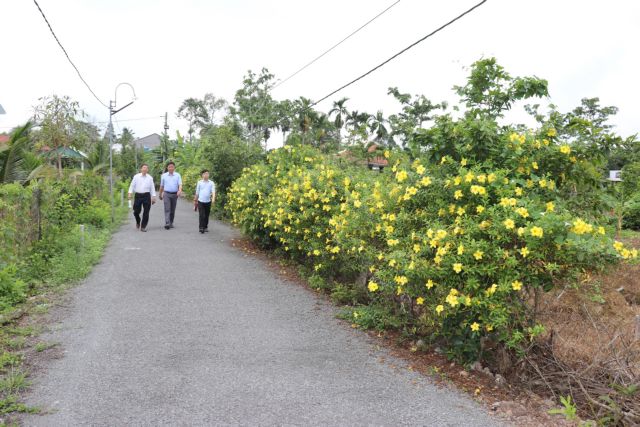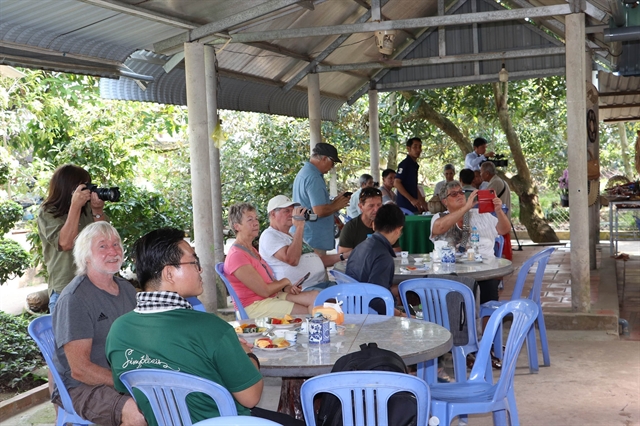Tiền Giang Province accelerates the development of new-style rural areas
Society – Economy - Ngày đăng : 14:24, 28/11/2024
 |
| A rural road in Đông Hoà Hiệp, an advanced new-style rural commune in Tiền Giang Province’s Cái Bè District, has solar-powered lighting and security cameras and flowers on its sides. – VNA/VNS Photo Minh Hưng |
TIỀN GIANG – Tiền Giang Province aims to be recognised by the Prime Minister as having completed the creation of new-style rural areas by 2025.
Under the national programme for building new-style rural areas, all 142 communes in the Cửu Long (Mekong) Delta province now meet the programme’s 19 criteria.
The criteria cover infrastructure, irrigation, electricity, environment, income, education, healthcare, social security, culture, and requirements in other spheres.
Nguyễn Văn Mẫn, director of the province Department of Agriculture and Rural Development, said the province plans to allocate approximately VNĐ3.3 trillion (US$133 million) to implement the programme in 2024-25.
Of this amount, VNĐ389 billion ($16 million) will come from the central budget, with the remainder sourced from local budgets and other channels.
These funds will be invested in rural roads, irrigation systems, schools, healthcare centres, and public welfare projects.
The province aims to establish 12 additional advanced new-style rural communes and nine exemplary new-style rural communes this year, bringing the total to 63 and 13 by the end of the year.
New-style rural communes will be elevated to advanced and then exemplary levels when they meet higher standards across the 19 criteria.
The implementation of this programme has significantly improved the quality of life for rural residents and enhanced the appearance of rural areas.
Phạm Thị Thuỷ, a resident of Hưng Thạnh, a new-style rural commune in Tân Phước District, said: "The province has widened the roads, and they are clean, making travel and goods transportation much easier.
"The lives of people in Hưng Thạnh have changed dramatically, with spacious concrete houses and clean rural roads."
The commune aims to be recognised as an advanced new-style rural commune by the end of this year.
Lê Trúc Hiền, deputy chairman of the Hưng Thạnh People’s Committee, said: “Since implementing the programme and building an advanced new-style rural commune, we have built more infrastructure, and the quality of life has improved for locals.”
The province is mobilising both officials and residents to participate in the construction of new-style rural areas, while maintaining and improving the quality of the programme’s 19 criteria.
It is also gathering resources to develop synchronised socio-economic infrastructure, protect the environment, and maintain green, clean, and safe rural areas.
Mẫn noted that the province has recognised the need to integrate the building of new-style rural areas with agricultural restructuring, rural economic development, urbanisation, improving the living standards of rural people, and promoting gender equality.
The province will develop favourable mechanisms and policies to support the construction of new-style rural areas, ensuring local residents, as the direct beneficiaries of the programme, receive the necessary assistance, he said.
It will implement preferential credit policies through the Vietnam Bank for Social Policies and the Vietnam Bank for Agriculture and Rural Development to help farmers restructure their farming practices in response to climate change and achieve higher production efficiency, he added.
It will promote the adoption of advanced farming techniques to enhance the quality and yield of agricultural products, ensuring they meet both domestic and export market demands.
It will focus on social welfare programmes and improving the quality of education, training, healthcare, and the overall standard of living for people in remote and rural areas.
Rural tourism
 |
| Visitors to the Năm On Tourism Site in Tân Phong Commune in Tiền Giang Province’s Cai Lậy District. – VNA/VNS Photo Minh Trí |
As part of the programme, localities have leveraged their agricultural strengths and potential to develop rural tourism.
Many farmers, co-operatives, and companies have begun offering tourism services on farms.
The Đông Nghi Agricultural Co-operative in Tam Hiệp Commune, Châu Thành District, for instance, raises around 300 dairy goats and produces a variety of goods recognised under the country’s “One Commune - One Product” programme.
It also provides tourism services, attracting 200-300 visitors on weekends and holidays and 50-100 on other days.
The co-operative has invested in amusement facilities like a swimming pool and a goat breeding area where tourists can experience raising goats, and a dining area for visitors.
Phan Thành Văn, chairman of the Tam Hiệp Commune People’s Committee, said the commune’s infrastructure, including roads and the electricity system, has been sufficiently developed and upgraded to allow local businesses to offer tourism services.
The province is currently developing tourism products related to rivers, orchards, the sea, historical and cultural heritage sites, traditional craft villages, and art performances, according to its Department of Culture, Sports and Tourism.
It boasts more than 40 rural tourism destinations, and hundreds of households are involved in producing handicrafts and various rural occupations while also offering tourism services.
The province has increased its efforts to promote tourism products, develop new tours, attract tourists, and collaborate with other provinces and cities to create inter-provincial tours.
Nguyễn Thanh Tuấn, deputy chairman of the Gò Công Tây District People’s Committee, said the district is combining tourism development with agricultural growth and new-style rural areas.
It has also intensified its efforts to raise public awareness about preserving traditional culture, he said.
The district is promoting its tourism potential, seeking investment in sustainable green tourism and ensuring benefits are shared between investors, local communities, and residents, he said.
Efforts to improve the quality of human resources in the tourism sector have also been stepped up, with training courses offered to tourism officials and service providers, he added. – VNS
